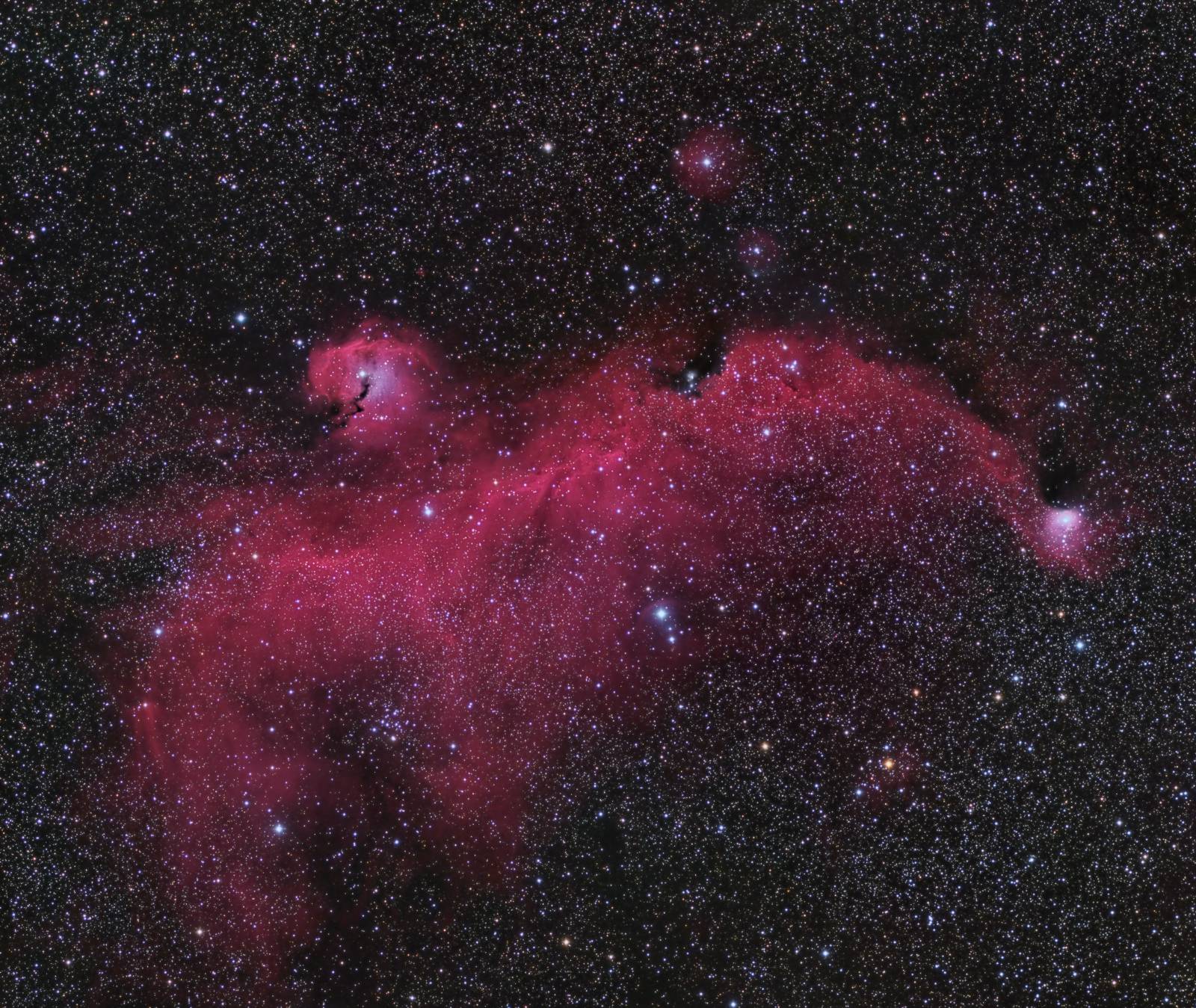IC 2177, The Seagull Nebula
 Click image for full size version
Click image for full size version
April 1, 2018
The Seagull Nebula includes several objects. The ‘head’ of the Seagull is catalogued as IC2177 (also as Gum 1, vdB 93, and Sh2-292). The image also contains many oth3er objects, including open clusters NGC2335 and NGC2343 towards the left of the image. Several reflection nebulae from the van den Bergh (vdB) catalogue lie in the field, and there is also much surrounding dust. The bright patch at right is Sh2-297. The entire complex lies about 3,650 light years from earth in the constellation Monoceros.
I prepared an annotated image that highlights the locations of many of the objects in this busy field.
 This image is dominated by clouds made mostly of hydrogen atoms that release energy as red light. I prepared a black-and-white version using a Ha filter that allows only this specific wavelength through. It shows more subtle details and smaller stars than the colour version.
This image is dominated by clouds made mostly of hydrogen atoms that release energy as red light. I prepared a black-and-white version using a Ha filter that allows only this specific wavelength through. It shows more subtle details and smaller stars than the colour version.
Note that I processed this about a year ago, but was never really happy with the result. I like this version better.
Tekkies:
Moravian G3-16200 EC camera, Optolong Ha, R, G and B filters, Takahashi FSQ-106 ED IV at f/3.6, Paramount MX. QHY5 guide camera on 175mm guide scope. Acquisition with the SkyX, focused with FocusMax, scripted with CCD Commander. All pre-processing and processing in PixInsight. Acquired from my SkyShed in Guelph. Acquired Dec 2016 – February 2017.
12x10m R, G, and B and 8x20m Ha unbinned frames (total= 8hr40m).
RGB:
Creation and cleanup: The BatchPreProcessing script was used to perform calibration, cosmetic correction and registration of all frames. ImageIntegration was used to make the Ha, R, G and B masters. The R, G, B masters were processed with DynamicBackgroundExtraction and then were combined to make an RGB image which was processed with PhotometricColorCalibration. The individual colour masters were saved for use in making the SynthL (see below).
Linear Noise Reduction: MultiscaleLinearTransform was used to reduce noise in the RGB image. Layer settings for threshold and strength: Layer 1: 3.0 0.8 Layer 2: 2.5, 0.7 Layer 3: 2., 0.6.
Stretching: ArcsinhStretch was used to slightly stretch the image, setting the black point so as to avoid any clipping. HistogramTransformation was applied to make a pleasing, bright image. CurvesTransformation was applied to boost contrast and saturation.
Synthetic Luminance:
Creation and cleanup of SynthL: The R, G and B channel masters were integrated (average, noise weighted, no rejection) using ImageIntegration to create the SynthL.
Deconvolution: A star mask was made to use as a Local Deringing Support image. A copy of the image was stretched to use as a range mask. Deconvolution was applied (50 iterations, regularized Richardson-Lucy, external PSF made using DynamicPSF tool with about 30 stars).
Linear Noise Reduction: MultiscaleLinearTransform was used to reduce noise in the background areas of the SynthL. Layer settings for threshold and strength: Layer 1: 3.0 0.75 Layer 2: 2.0, 0.6 Layer 3: 1.0, 0.3.
Stretching: HistogramTransformation was applied to the SynthL to make a pleasing, bright image.
Noise Reduction and Re-Stretch: TGVDenoise was applied in L*a*b* mode with 300 iterations with a range mask applied to protect high signal areas. This was followed by a HistogramTransformation to raise the black point (but with no clipping).
H-alpha:
Deconvolution: A star mask was made to use as a Local Deringing Support image. A copy of the image was stretched to use as a range mask. Deconvolution was applied (50 iterations, regularized Richardson-Lucy, external PSF made using DynamicPSF tool with about 20 stars).
Linear Noise Reduction: MultiscaleLinearTransform was used to reduce noise in the background areas of the Ha image. Layer settings for threshold and strength: Layer 1: 3.0 0.75 Layer 2: 2.0, 0.6 Layer 3: 1.0, 0.3.
Stretching: HistogramTransformation was applied to the Ha to make a pleasing, bright image.
Noise Reduction and Re-Stretch: TGVDenoise was applied in Lab mode with 300 iterations with a range mask applied to protect high signal areas. This was followed by a HistogramTransformation to raise the black point (but with no clipping).
Combining SynthL, RGB and Ha:
SynthLRGB: The processed SynthL was applied to the RGB image using LRGBCombine.
SynthLHaRGB: PixelMath was used to add 60% Ha to the red channel and 7% Ha to the blue using a mask to protect stars. Background was protected by limiting the PixelMath application to pixels were Ha was brighter than SynthL.
Additional Processing:
Shrinking the Stars: MorphologicalTransformation was used in Morphological Selection mode (Selection 0.13, strength 0.7) with a star mask to slightly reduce the size of the stars.
Sharpening: Using a mask to protect stars, background and dim nebulosity, MultiscaleLinearTransform was applied to sharpen layers 2 and 3 (bias of 0.1 for both), followed by two applications of UnsharpMask (scales of 0.9 and 5 pixels, each blended in at 30%).
Final Steps: Background, nebula and star brightness, contrast and saturation were adjusted in several iterations using Curves with masks as required. The blue areas from the RGB image were used to target a slight increase in blue in specific areas, particularly the ‘head’ of the Seagull.
Image scale is about 3.2 arcsec per pixel for this camera/telescope combination.






Leave A Comment